Hey there! Today, I want to delve into the intriguing world of apples and shed light on why they are known as “false fruits.” If you’ve ever wondered why apples are called false fruits, or if you’re currently studying this topic in class 12, you’ve come to the right place. Let’s explore the unique characteristics of apples and uncover what sets them apart in the realm of botanical classification.
Key Takeaways:
- Apples are classified as false fruits because the edible portion of the fruit comes from the hypanthium, not the ovary itself.
- True fruits of apples are the small, hard seeds found in the core.
- The structure of an apple fruit consists of a fleshy portion formed from the hypanthium and the core containing the true fruits.
- Understanding the classification of apples as false fruits helps deepen our understanding of plant reproduction and fruit diversity.
- Apples are known for their crisp and juicy texture, making them a popular choice for consumption.
Botanical Classification of Apple
According to botanical classification, apples belong to the Rosaceae family and the Malus genus. They are classified as false fruits because the fleshy portion that is commonly consumed is not formed from the ovary tissue, but rather from other floral parts. The true fruits of apples are the small, hard seeds found in the core of the fruit.
Apples are a popular fruit enjoyed worldwide for their crisp texture and sweet flavor. They come in a variety of colors, sizes, and flavors, making them a versatile ingredient in both sweet and savory dishes. From classic apple pies to refreshing salads, apples add a touch of natural sweetness and crunch to various culinary creations.
To better understand the classification of apples as false fruits, let’s take a closer look at the botanical structure of an apple:
| Botanical Structure of Apple | Classification |
|---|---|
| Fleshy Portion | False Fruit |
| True Fruit | Small, hard seeds found in the core |
The image above illustrates the botanical classification of an apple, emphasizing the distinction between the false fruit and the true fruit. The fleshy portion, represented as the false fruit, develops from the hypanthium, a modified floral cup formed by the fusion of petals and sepals. On the other hand, the true fruit consists of the small, hard seeds found in the core, which are the actual ovary-derived fruits.
“The classification of apples as false fruits highlights the unique nature of their fruit structure, where the part commonly consumed is not derived from the ovary tissue but rather from other floral parts.”
Understanding the botanical classification of apples sheds light on the diverse nature of fruits and their complex development. While apples are classified as false fruits, they remain a delicious and nutritious option that adds flavor and texture to various culinary creations.
Apple as a False Fruit
As mentioned earlier, apples are classified as false fruits because the part of the fruit that is commonly eaten is not derived from the ovary tissue. Instead, it is formed from the hypanthium, which is a floral cup formed by the fusion of petals and sepals. The true fruits of apples are the small, hard seeds found in the core.
Apple Classification Explained
The classification of apples as false fruits is based on their unique fruit structure. While the fleshy part of the apple is often referred to as a fruit, it is not the true fruit in a botanical sense. The true fruit of the apple is the core, which contains the seeds. It is the part of the apple that develops from the ovary tissue. The fleshy part of the apple, formed from the hypanthium, is a modified floral structure that is not involved in seed production.
When we think of apples, we typically think of the juicy, sweet flesh that we enjoy eating. However, this part of the apple is not the true fruit. The true fruit of the apple is actually the core, which houses the seeds. The fleshy part that we consume is known as a false fruit.
Apples belong to the Rosaceae family and the Malus genus, further categorizing them as false fruits. The term “false fruit” is used to describe fruits that are not derived from the ovary tissue of a flower. The fleshy portion of the apple is formed from the hypanthium, a modified floral structure that surrounds the true fruits.
The unique fruit structure of apples allows them to be classified as false fruits. This distinction is important in the field of botany and helps us understand the diversity of fruit types. By recognizing that apples are false fruits, we gain insight into their biology and development.
Apples are an interesting example of false fruits because they challenge our understanding of what constitutes a fruit. The classification of apples as false fruits highlights the intricate and fascinating nature of plant biology.
False Fruit Definition
A false fruit, also known as a pseudocarp, is a fruit-like structure that develops from floral parts other than the ovary. It is formed from the modification of other floral tissues, such as the receptacle or hypanthium.
False fruits are often edible and may contain seeds, but the part that is commonly consumed is not derived from the ovary tissue.
Key Characteristics of False Fruits:
Differentiation: False fruits are distinguished by their origin from floral structures other than the ovary. They develop from modified receptacles, hypanthiums, or other floral parts.
Eating Portion: The edible portion of false fruits is derived from the modified floral tissue and is commonly consumed.
Seeds: False fruits may contain seeds, but the seeds are not the main part consumed.
Understanding the concept of false fruits is crucial in the study of botany and plant classification. It allows us to appreciate the diverse forms and structures that fruits can take. False fruits play a significant role in the reproductive strategies of many plants and contribute to the overall biodiversity of the plant kingdom.
“False fruits are fascinating examples of nature’s creativity in floral development and fruit formation. They showcase the intricate relationships between plants, flowers, and the organisms that interact with them.”
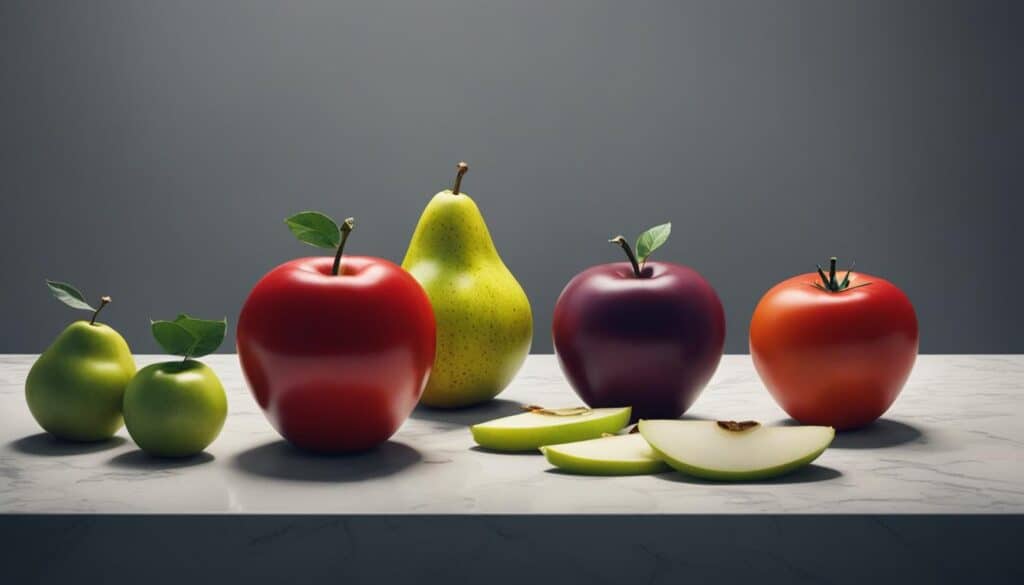
Types of Fruits
When it comes to fruits, there are various types that can be classified based on their characteristics and formation. Let’s explore the different categories of fruits:
1. True Fruits:
True fruits are formed from the ovary tissue of a flower and contain seeds. They develop after fertilization and play a vital role in the reproduction of flowering plants. Examples include apples, oranges, and strawberries.
2. False Fruits:
False fruits, like apples, are formed from floral parts other than the ovary tissue. The edible portion of false fruits is derived from structures such as the hypanthium, which is the floral cup. While they may contain seeds, the fleshy part we consume does not originate from the ovary. Apples are a perfect example of false fruits.
3. Aggregate Fruits:
Aggregate fruits form from multiple ovaries within a single flower. Each ovary develops into a small, separate fruit, and when they mature, they fuse together to create a larger fruit. Examples of aggregate fruits include raspberries and blackberries.
4. Composite Fruits:
Composite fruits develop from a cluster of flowers that fuse together, creating a single fruit. Each individual flower contributes to the overall structure of the composite fruit. Pineapples are a classic example of composite fruits.
Now that we’ve explored the different types of fruits, let’s take a moment to appreciate the variety and complexity of nature’s delicious creations.
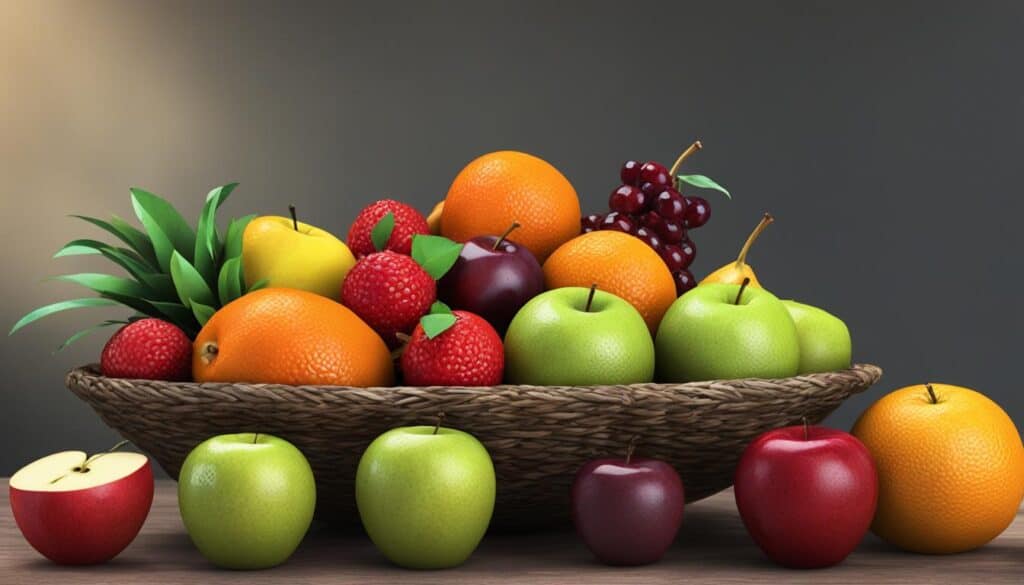
| Type of Fruit | Example |
|---|---|
| True Fruits | Apple |
| False Fruits | Strawberry |
| Aggregate Fruits | Raspberry |
| Composite Fruits | Pineapple |
Apple Biology Class 12
The study of apple biology in class 12 is an exciting exploration of the intricate structure and classification of apples as false fruits. Through the lens of biology, students delve into the fascinating world of apples, gaining a deeper understanding of their botanical classification, unique fruit structure, and the distinction between false fruits and true fruits.
Botanical Classification of Apples:
Apples belong to the Rosaceae family and the Malus genus, according to botanical classification. The classification as false fruits is derived from the fact that the fleshy portion of the apple, which is commonly consumed, is not formed from the ovary tissue. Instead, it develops from other floral parts, specifically the hypanthium. The true fruits of apples are the small, hard seeds found in the core of the fruit.
Understanding False Fruits and True Fruits:
- False fruits, like apples, are formed when the edible portion of the fruit is derived from floral parts other than the ovary itself.
- True fruits, on the other hand, develop from the ovary tissue and contain seeds.
- Apples exemplify this distinction as the core, containing the seeds, represents the true ovary-derived fruit, while the fleshy portion originates from the hypanthium.
The study of apple biology in class 12 offers students a comprehensive understanding of plant reproduction and the incredible diversity of fruit types. By delving into the complexity of apple structure and classification, students gain a deeper appreciation for the intricacies of nature and the fascinating world of botany.
“The beauty of apple biology lies in discovering the hidden wonders of these false fruits and unraveling the secrets behind their unique structure.” – Apple enthusiast
Through hands-on experiments, interactive learning activities, and engaging discussions, class 12 students explore the world of apple biology, nurturing their scientific curiosity and expanding their knowledge of plant anatomy and reproduction.
Next, let’s explore the fascinating structure of an apple fruit in greater detail.
Apple Fruit Structure
The structure of an apple fruit consists of several parts. The fleshy portion of the fruit, which is commonly consumed, is formed from the hypanthium, a floral cup that surrounds the true fruits. The true fruits are the small, hard seeds found in the core of the fruit. The core also contains the ovary tissue, which is not typically consumed. This unique fruit structure is what classifies apples as false fruits.
When you take a bite into a delicious apple, you may not realize the intricate structure that lies within. Let’s explore the different components of an apple fruit:
- The fleshy portion of the fruit, often referred to as the “meat” of the apple, is what we eat and enjoy. It is formed from the hypanthium, a modified floral cup that contains a sweet and juicy pulp.
- Surrounding the fleshy portion are the true fruits of the apple. These are the small, hard seeds that are commonly referred to as apple seeds.
- Deep within the apple, at the center of the fruit, lies the core. The core contains the ovary tissue of the flower, which is not typically consumed.
It is important to note that the fleshy portion of the apple, which is formed from the hypanthium, is the part that is most commonly consumed. The true fruits, the seeds, are often discarded or left behind when eating an apple.
Differentiating between False Fruits and True Fruits
Understanding the structure of an apple is essential to differentiate between false fruits and true fruits. While the fleshy portion of the apple is what we commonly refer to as the “fruit,” it is actually a modified floral structure formed from the hypanthium. The true fruits of the apple, the seeds found in the core, are the actual fruits in a botanical sense.
“The structure of an apple fruit is fascinating. The fleshy part, which we eat, is actually a modified floral cup known as the hypanthium. It surrounds the true fruits, the seeds found in the core of the fruit. This unique structure classifies apples as false fruits.” – Apple enthusiast
Next, we will delve deeper into the characteristics of false fruits and explore the various classifications of apples.
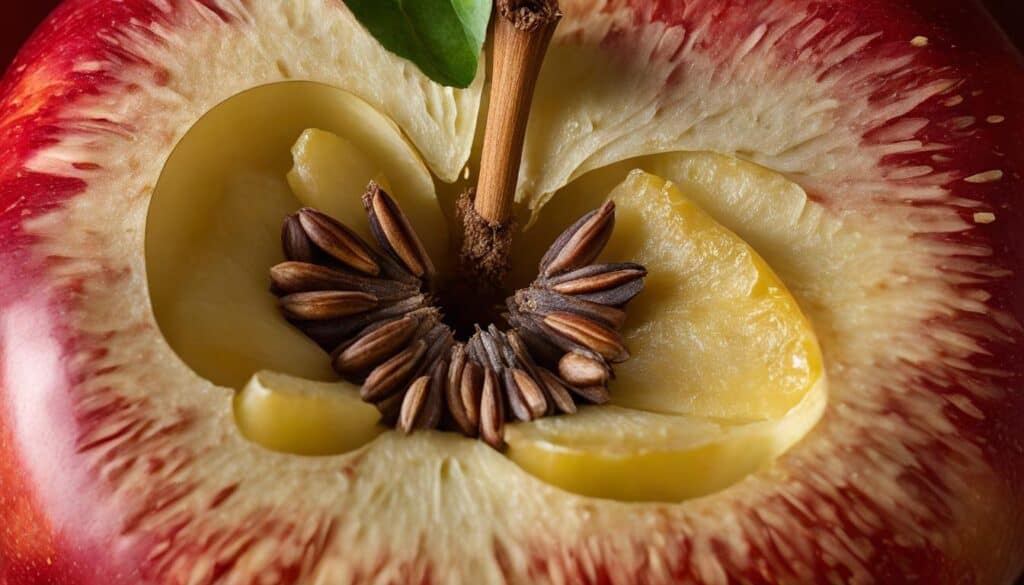
Apple as a False Fruit Explained
The term “false fruit” refers to fruits that do not originate from the ovary tissue of a flower. In the case of apples, the part that is commonly consumed, the fleshy portion, is formed from the hypanthium. The hypanthium is a modified floral cup that gives rise to the delicious and juicy part of the apple. However, the true fruits of apples are the small, hard seeds found in the core.
This distinction between the fleshy portion and the true fruits is what classifies apples as false fruits. While the core represents the true ovary-derived fruit, the rest of the apple’s edible portion comes from the hypanthium, a modified floral structure.
“Apples symbolize the harmonious blend of maternal love through their fleshy sweetness and the hidden potential for new life within their core.” – Unknown
Apple Anatomy: From Core to Hypanthium
Understanding the anatomy of an apple can shed more light on why it is considered a false fruit. The core of the apple contains the true ovary-derived fruit, enclosing the seeds that hold the potential for future apple trees to grow. This core is surrounded by the hypanthium, a modified floral cup formed by the fusion of petals and sepals. It is from this floral cup that the flesh of the apple develops, serving as the tasty and nutritious part we enjoy.
To visualize the structure:
| Part of the Apple | Description |
|---|---|
| Core | The true ovary-derived fruit that contains the seeds necessary for reproduction. |
| Hypanthium | A modified floral cup formed from the fusion of petals and sepals that gives rise to the fleshy portion of the apple. |
So, next time you bite into a juicy apple, remember that while it may be considered a false fruit, it is still packed with flavor and nutritional benefits!
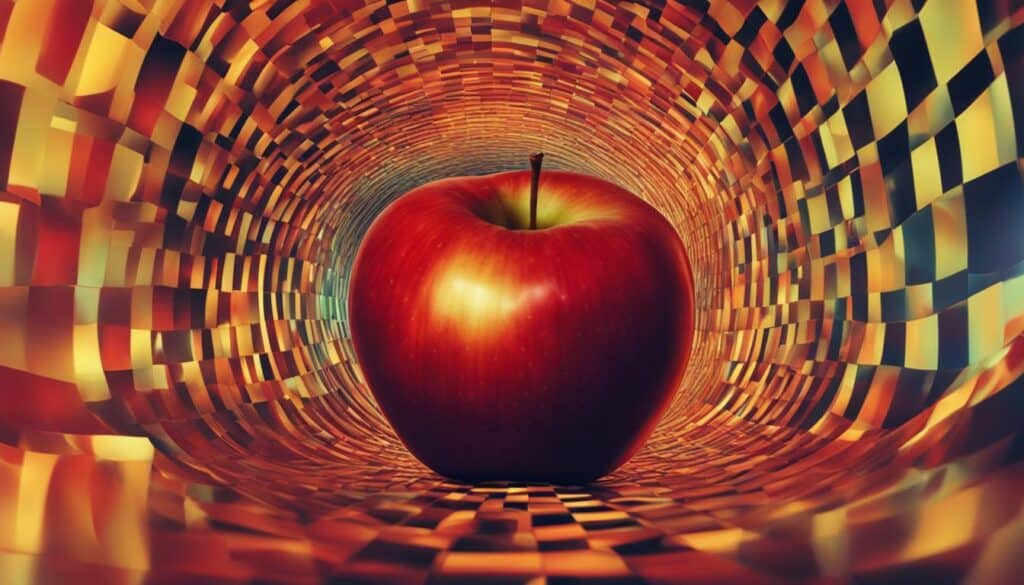
Apple Classification Explained
In understanding why apples are referred to as false fruits, it is crucial to delve into their unique fruit structure. Although often regarded as a fruit, the fleshy part of the apple does not meet the botanical definition of a true fruit. Instead, the true fruit of the apple lies within its core, where the seeds are contained. This core develops from the ovary tissue of the apple flower. On the other hand, the fleshy part of the apple, known as the edible portion, is derived from the hypanthium, which is a modified floral structure unrelated to seed production.
By classifying apples as false fruits, we can recognize the distinct characteristics of their fruit structure, highlighting the differentiation between the fleshy portion and the true fruits.
| True Fruit | Fleshy Portion |
|---|---|
| The core of the apple | Derived from the hypanthium |
| Develops from the ovary tissue | A modified floral structure |
| Contains the seeds | Not involved in seed production |
I believe this unique classification adds to the intrigue and diversity of the apple as a false fruit. Understanding the complex nature of fruits and their classifications is essential in appreciating the wonders of botany.
Apple Fruit Characteristics
Apples are beloved for their unique characteristics that make them a favorite fruit among many. Let’s explore the distinct attributes that set apples apart:
1. Fleshy Texture and Sweet Taste
Apples are known for their delightful fleshy texture and sweet taste. Each bite offers a satisfying crunch that varies depending on the apple variety.
2. Crisp and Juicy
The edible portion of the apple, formed from the hypanthium, is often crisp and juicy. Whether you prefer a refreshing bite or a juicy explosion in your mouth, apples deliver a pleasant sensation.
3. Small and Hard Seeds
The true fruits of apples are the small and hard seeds found in the core. Despite their size, these seeds play an essential role in apple propagation.
4. Wide Variety of Colors and Flavors
Apples come in a diverse range of colors and flavors, making them a versatile fruit. From the vibrant red of a Granny Smith to the golden hue of a Golden Delicious, each variety offers a distinct taste and appearance.
5. Culinary Versatility
Apples are not just enjoyed as a fresh snack; they also shine in various culinary applications. Whether baked into pies, simmered into sauces, or sliced into salads, apples add a burst of flavor and texture to countless recipes.
| Characteristic | Description |
|---|---|
| Fleshy Texture and Sweet Taste | Apples offer a satisfying crunch and a delightful sweetness. |
| Crisp and Juicy | Apples provide a crisp and juicy eating experience. |
| Small and Hard Seeds | Apples contain small and hard seeds that are vital for propagation. |
| Wide Variety of Colors and Flavors | Apples come in a diverse array of colors and flavors. |
| Culinary Versatility | Apples are versatile ingredients that enhance numerous recipes. |
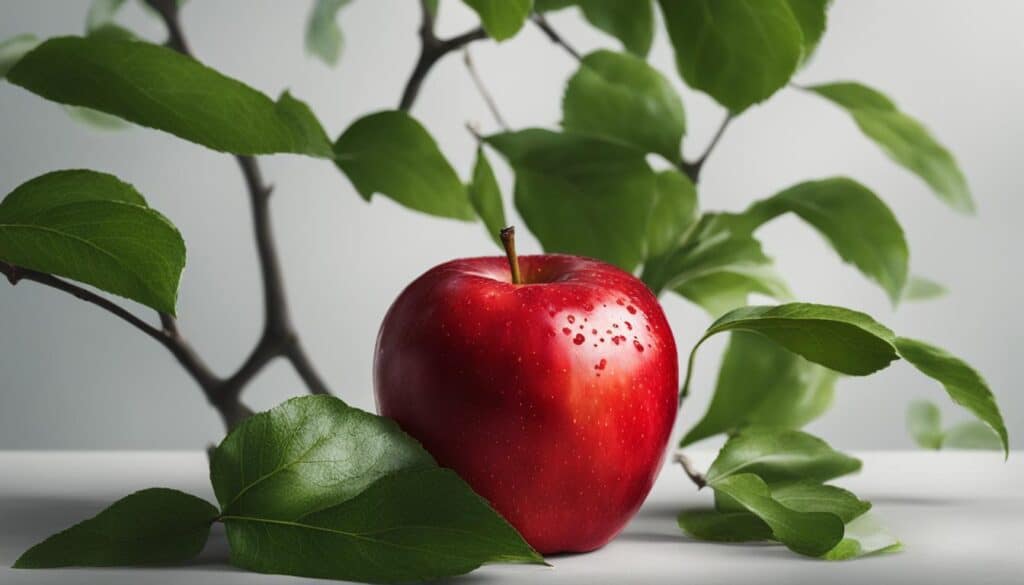
Next, we will delve into the fascinating world of false fruits and explore how apples fit into this classification.
Conclusion
In conclusion, apples are known as false fruits due to their unique fruit structure. Unlike true fruits, which develop from the ovary tissue, the edible part of an apple is derived from the hypanthium, a modified floral cup. This fleshy portion, often consumed and enjoyed for its crisp and juicy texture, is not involved in seed production. The true fruits of apples are the small, hard seeds found in the core.
Understanding the distinction between the fleshy portion and the true fruits of apples contributes to our knowledge of botanical classification and the diversity of fruit types. By recognizing the specific characteristics of apples as false fruits, we gain insight into the complexity and intricacies of plant reproduction. Apples, classified under the Rosaceae family and the Malus genus, exemplify how nature has evolved to create a wide array of fruit structures.
Exploring the biology and classification of apples as false fruits is an essential component of educational curricula, particularly at the class 12 level. This knowledge enhances our understanding of plant anatomy and physiology, providing a basis for delving deeper into the botanical world. Furthermore, the popularity and versatility of apples in culinary and agricultural contexts make it imperative to comprehend their unique fruit structure and classification.
FAQ
Why is apple called a false fruit?
Apple is called a false fruit because the edible portion of the fruit is derived from the hypanthium, which is formed from the fused base of petals and sepals, rather than the ovary itself.
What is the botanical classification of apple?
Apple belongs to the Rosaceae family and the Malus genus.
Why is apple classified as a false fruit?
Apple is classified as a false fruit because the fleshy portion that is commonly consumed is not formed from the ovary tissue, but rather from other floral parts.
What is the definition of a false fruit?
A false fruit, also known as a pseudocarp, is a fruit-like structure that develops from floral parts other than the ovary.
What are the types of fruits?
Fruits can be classified into several types, including true fruits, false fruits, aggregate fruits, and composite fruits.
What does the study of apple biology in class 12 involve?
The study of apple biology in class 12 involves understanding the structure and classification of apples as a false fruit, as well as the difference between false fruits and true fruits.
What is the structure of an apple fruit?
The fleshy portion of an apple fruit is formed from the hypanthium, while the true fruits are the small, hard seeds found in the core of the fruit.
Why are apples called false fruits?
Apples are called false fruits due to their unique fruit structure, where the fleshy part that is commonly consumed is not the true fruit in a botanical sense. The true fruit of the apple is the core, which contains the seeds.
What are the characteristics of an apple fruit?
Apples are known for their characteristic fleshy texture, sweet taste, and variety of colors and flavors.

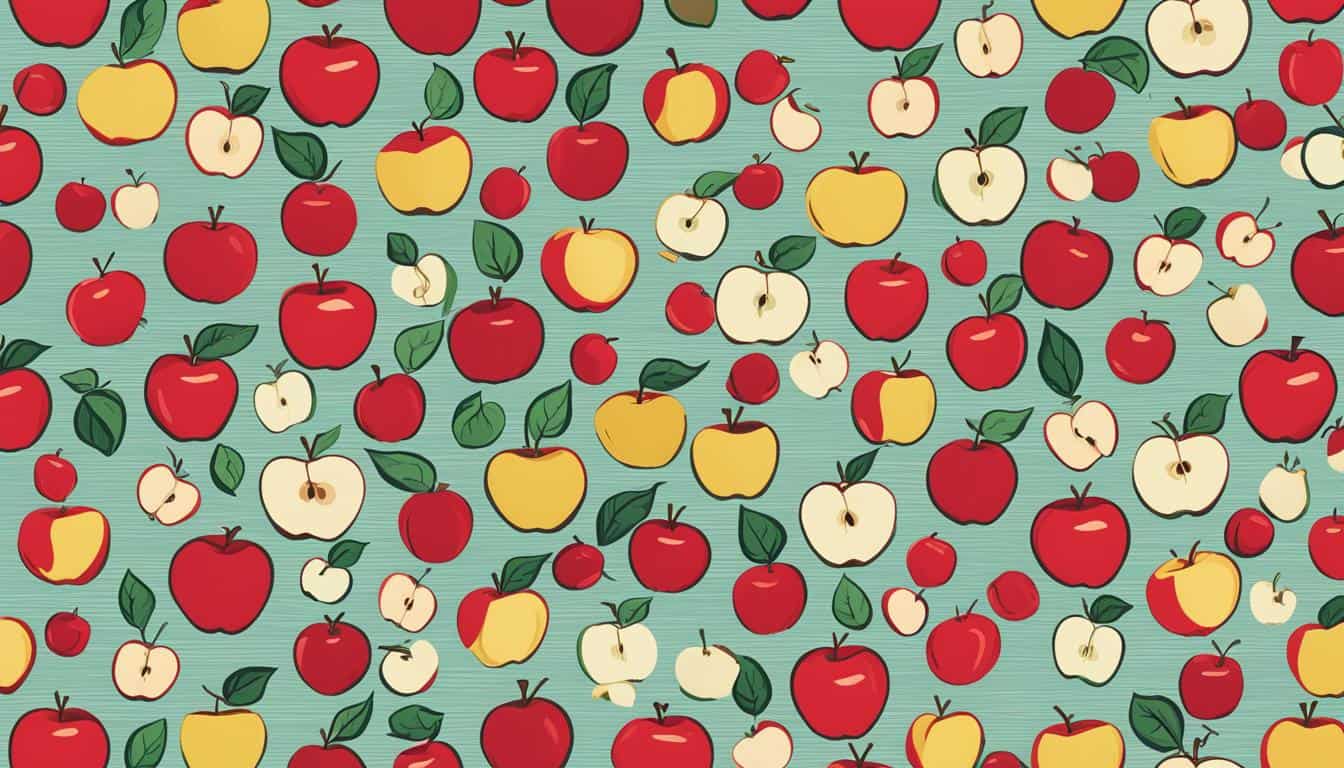



Leave a Reply